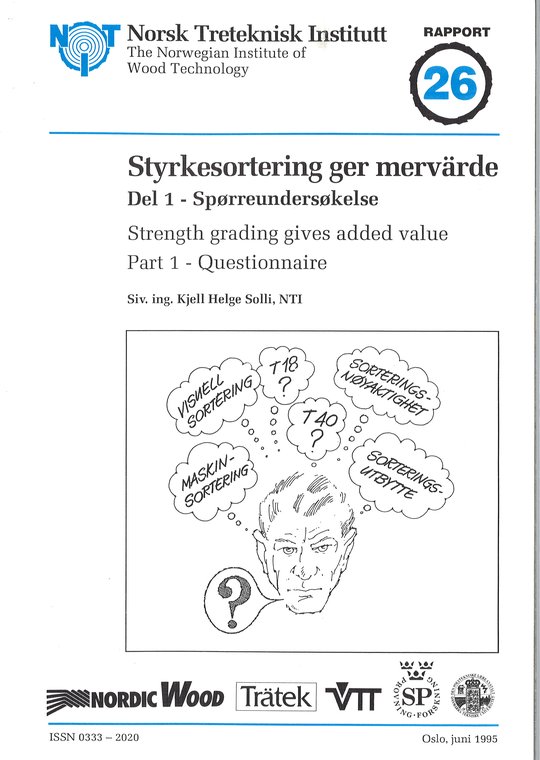26: Styrkesortering ger mervärde
Forfatter: Kjell Helge Solli
Rapport 26, 1995
96 s.
200,- (Gratis for medlemmer)
Last ned
Sammendrag
I forbindelse med det nordiske prosjektet Styrkesortering ger mervärde ble det gjennomført en relativt omfattende spørreundersøkelse som hadde som hensikt å kartlegge forskjellige meninger og fakta rundt begrepet styrkesortering generelt, maskinsortering spesielt. Målet med undersøkelsen har blant annet vært å samle tilstrekkelig informasjon til å kunne legge et grunnlag for en kravspesifikasjon til framtidens styrkesorteringsmarkiner.
Spørreundersøkelsen rettet seg mot tre målgrupper: a) Forbrukere av styrkesortert trevirke, b) Produsenter med styrkesorteringsmaskin og c) Produsenter med visuell styrkesortering. På denne måten har en forsøkt å fange opp signaler så vel fra forbruker- som produsentsiden.
Undersøkelsen viser at forbrukerne flest velger konstruksjonsvirke (maskinsortert vs. visuelt sortert) på bakgrunn av hva som er billigst/lettest tilgjengelig. Det har imidlertid blitt en økende tendens blant forbrukere som er underlagt kontrollordninger å velge maskinsortert virke. Dette henger sammen med krav til egenkontroll og dokumentasjon av kvaliteten.
Både bedrifter med maskinsortering og visuell sortering gjør valg av sorteringsklasser etter hva kundene bestiller. Ofte sorteres ikke de høyeste klassene ut da det ikke er etterspørsel etter dem. Det disse to gruppene setter som høyeste krav/ønske til en styrkesorteringsmaskin, er følgende:
- driftssikkerhet
- sorteringsnøyaktighet
- mulighet for sikker egenkontroll
Stor sorteringshastighet ble ikke gitt særlig høy prioritet. Dette skyldes blant annet at sorteringshastigheten ikke er avhengig av maskinen alene.
Summary
In 1994 - 95 the four Nordic countries (Denmark, Finland, Norway and Sweden) co-operated in a project with the purpose to increase the knowledge of strength grading methods in general and machine strength grading methods in particular. The project was divided into the following three parts:
- Part 1 Questionnaire.
- Part 2 Available techniques.
- Part 3 Specification on machine requirements.
This report is based on the results from Part 1, Questionnaire.
To obtain relevant information from all parts who are involved in the grading question, the industry was divided into three main groups:
- Those who use strength graded timber (f, inst. producers of glulam, roof trusses, prefabricated houses etc.).
- Those who produce machine strength graded timber.
- Those who produce visual strength graded timber.
Around 200 different users and producers were contacted in the four countries. They were all asked questions with relevance to grading and grading methods today and tomorrow. The report answers typical questions such as:
(Users of strength graded timber)
- How much machine graded timber did you use this year (1994)?
- Why do you prefer machine/visual strength graded timber?
- Which strength classes do you use or would you like to use?
- Do you get enough of the strength class you want?
- Are you satisfied with the quality?
- Do you need more information about machine strength grading and machine strength graded timber?
(Producers of machine strength graded timber:)
- What kind of machine do you use?
- Are you satisfied with the machine - if not, why?
- What are the most important machine properties?
- What speed do you use during grading?
- Which strength classes do you grade - and why?
- How many parallel classes do you grade?
- Do you need more information about machine strength grading and machine strength graded timber?
(Producers of visual strength graded timber:)
- Why do you prefer visual grading?
- Do you plan to buy a strength grading machine?
- What are your best arguments against buying a strength grading machine?
- What are the most important properties a machine should have?
- Which strength classes do you grade - and why?
- Do you grade combination classes (f. ex. "T18 and better"), if yes - which ones and why?
- How many parallel classes do you grade?
- Do you need more information about machine strength grading and machine strength graded timber?
The report concludes among many other things with the following points based on the actual answers:
- The market for machine strength graded timber will increase in the coming years.
- The machines today are not accurate enough in grading.
- There is obviously a need for a better service supply.
- Machines without need for complementary visual grading will be preferred.
- The necessary additional visual grading is not always satisfactorily performed.
- The machine speed is not that important, as the machine normally is part of the whole production line, and other machines often determine the resulting speed.
- The users of strength graded timber, who are members of external quality control systems, often prefer machine strength graded timber because the demands on internal control is easier to meet (you cannot use visual strength grading rules on machine graded timber).
- The information about machine strength grading and machine strength graded timber should be better, Particularly with regard to rules and standards that will be included in the new CEN-system.
